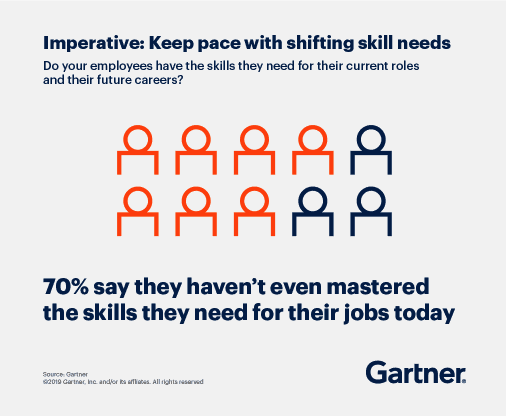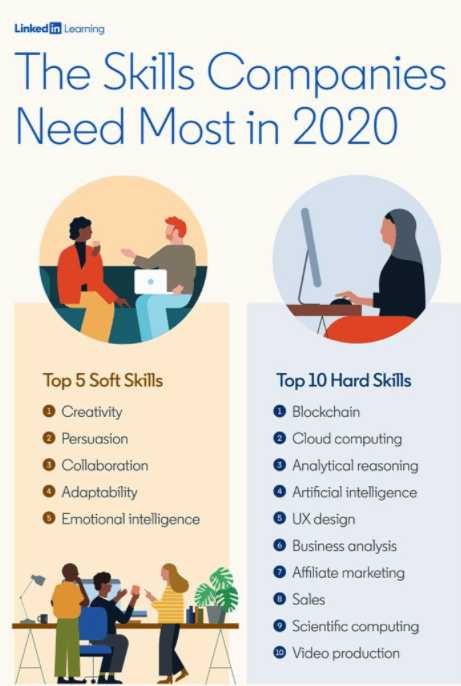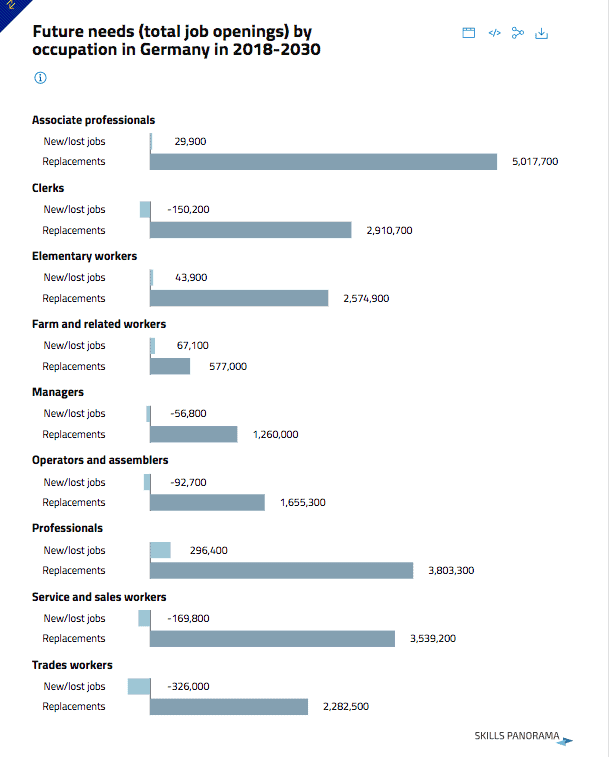What you need to know about the skills gap

Tech recruiters find it extremely hard to hire highly-skilled employees. In fact, 64% of HR managers believe that employees won’t be able to keep up the pace with future skills development needs. While 70% of employees admit they haven’t yet acquired all the necessary skills to perform their current job. While the disruption caused by the COVID-19 pandemic has disrupted the US labor market, the skills gap will remain once the crisis is over.
 If the skills gap is not addressed, it might lead to a serious recruitment crisis. In the following article, we’re going to talk about what strategic, forward-looking talent managers should know about the skills gap and what they can do to mitigate it.
If the skills gap is not addressed, it might lead to a serious recruitment crisis. In the following article, we’re going to talk about what strategic, forward-looking talent managers should know about the skills gap and what they can do to mitigate it.
What is the skills gap?
Before we move on to discussing what tech skills employees lack and what will happen if the skills gap is not addressed, first let’s agree on what the skills gap actually is. There are two definitions that are commonly used:
Definition one:
The first one applies to the difference between the skills required for a job and the skills an employee actually possesses.
Definition two:
While the second definition of the ‘skills gap’ is used to describe the difference between the skills that employers want, as shown by their job advertisements, and those that are available from workers looking for a job.
Why there is a skills gap: what the experts say
The skills gap can be observed in every sector and no company irrespective of its size is immune to it. It’s particularly burdensome in the United States, which has the highest number of unfulfilled jobs. According to the U.S. Department of Labor Bureau of Labor Statistics as of early January 2019, there were 6.9 million unfilled job vacancies. How so?
Some claim that American employers have unrealistic expectations regarding job applicants. Peter Capelli says:
“Employers are demanding more of job candidates than ever before. They want prospective workers to be able to fill a role right away, without any training or ramp-up time. To get a job, you have to have that job already.”
Others blame it on digital transformation. In fact, according to the World Economic Forum, only 27% of small companies and 29% of large companies claim to have the digital talent needed to perform jobs effectively. Furthermore, 75% of Business Roundtable CEOs complain about not being able to fill vacancies in STEM-related fields (i.e. computer programmers, web developers, statisticians, etc.).
What tech skills do employees lack?
To further demonstrate the seriousness of the skills gap, we had a look at statistics provided by the TechServe Alliance. These reported no tech job growth in the US in May, August, and September of 2018 – this hasn’t happened for a long time in US history.
Mark Roberts, the CEO of TechServe Alliance says that:
“This is totally a supply-side phenomenon. There are simply not enough qualified workers to meet demand.”
This provokes two questions: what tech skills do employees lack and what tech positions are hard to fill?
LinkedIn identified the top 10 hard skills that will be in high demand in 2020, their list includes Blockchain, cloud computing, analytical reasoning, artificial intelligence, UX design, and others.

When it comes to job vacancies, according to Monster.com tech employers complain about not being able to fill the following positions:
- Data Analytics
- Security
- Cloud computing
- Cybersecurity
- IT Architecture
What will happen if the skill demand is not met? Let us get to it right now.
What will be the consequences of not addressing the skills gap?
If companies don’t take appropriate steps to mitigate the skills gap, it will have severe consequences, including:
Millions of unfulfilled jobs and lost revenue
According to a study by Korn Ferry International, skill shortages will lead to 85.2 million unfilled job positions, which in turn will result in $8.5 trillion in unrealized revenue. They estimate that the skills gap will impact 20 major economies across three sectors: 1) financial and business services, 2) technology, media, and telecommunications, and 3) manufacturing.
Loss in productivity and a decrease in morale
More skilled employees will have to support the less skilled ones which might lead to decreased productivity, as they’ll be expected to put in more work hours. This will also result in employee dissatisfaction.
Talent war
Highly skilled employees will be scarce, while the demand for them will be high. As a consequence, this might result in talent wars among recruiters who will compete for the best talent. This will give highly-skilled employees more bargaining power and might result in job-hopping, which leads us to our next point.
High turnover
Employee dissatisfaction, as well as talent wars, will result in high employee turnover among the most talented employees. They will leave their current employers searching for more suitable positions, including higher pay and a healthier work environment.
Inability to increase production to meet demand
There won’t be enough workers to perform the job, which will have an adverse effect on meeting demand. This is already starting to happen in the US, where, in April 2019, the number of job openings was higher than the number of unemployed Americans.
What can companies do to reduce the skills gap?
Is there anything that strategic, forward-looking talent managers can do to address this problem? Here are a few tactics you can use to mitigate the skills gap.
Use competency mapping tools
Competency mapping tools like DevSkiller TalentBoost allow employees to understand what career development efforts they should be making and to what end result. From the perspective of the employer, competency mapping increases your awareness of existing skill sets as well as skills gaps in the organization.
Design a formal training plan
Employees, especially the most talented and ambitious ones, care about their career development. If you want to attract and retain the best talent, as well as reduce your internal skills gap, then create a skills development plan. Identify all the required skills, verify their supply and enable your employees to attend relevant courses to acquire the necessary skills.
You can include both internal and external training courses in your skill development plan instead of solely relying on external institutions like universities to educate your employees.
Mark Lipscomb, vice president of global talent at Adobe said:
“It is extremely hard to find candidates with experience/skills in data science, artificial intelligence, machine learning, and cloud engineering”
However, instead of sitting around doing nothing, Adobe decided to tackle this problem by providing a great learning environment for their employees. They created an Intense Machine Learning Training course for their technical people which lasts 20 weeks and is very in-depth. It includes both on-demand and in-person training on numerous topics globally. On top of that, Adobe offers its employees access to a learning fund of up to $10,000 per year for academic degrees, top credential programs, technical specifications, etc.
Introduce mentoring programs
Approximately 70% of learning happens on the job, and an additional 20% occurs with and through others. Introduce mentoring programs where less experienced employees can learn from more experienced colleagues.
Challenge your recruitment strategy
Employers are demanding, with over 40% of college graduates being underemployed in their first job. Knowing from experience, if they’re underemployed in their first job, this situation will most probably persist for five years after graduation. Does this call for a question, are employers’ demands realistic? Probably not.
Tracy McCarthy, Chief Human Resource Officer of SilkRoad says
“Challenge your thinking about the level of experience and skills you are demanding of applicants and look for a balance of specific technical skills and critical success skills, work attitudes, and self-management skills.”
Cooperate with educational institutions
It’s hard to design academic curriculums that would reflect business needs considering the pace of technological advancements and fast-changing job requirements. Nevertheless, it’s worth it for companies to partner up with universities and other educational institutions to help them design their curriculums.
Additionally, it might be beneficial to consider introducing apprenticeships/internships as part of the course of study where students split their time between classroom study and on-the-job training. This model is popular in Germany and it seems to work effectively. Germany has a highly skilled workforce, with a high employment rate and strong job growth.
 We must join forces to address the skills gap or economies will suffer
We must join forces to address the skills gap or economies will suffer
The skills gap is a problem prevalent globally. If we don’t try to mitigate it, it will reach an unprecedented scale and will have serious economic consequences. Think about productivity loss, unfilled demand, talent wars, and high employee turnover.
There are a number of steps that strategic, forward-looking talent managers can take to reduce the skills gap. For example, introduce skill mapping to verify the skills needed to perform a job effectively and spot any skill deficiencies.
Employers should also invest in employee skill development by introducing formal training plans, and offering internal and external training courses. Partnering up with educational institutions and helping them design their curriculums is also a great way of reducing the skills gap. Good luck with your fight, and if you need a competency mapping tool, then be sure to check out Devskiller TalentBoost.
Image credit: Nicole Wolf on Unsplash
Share post
